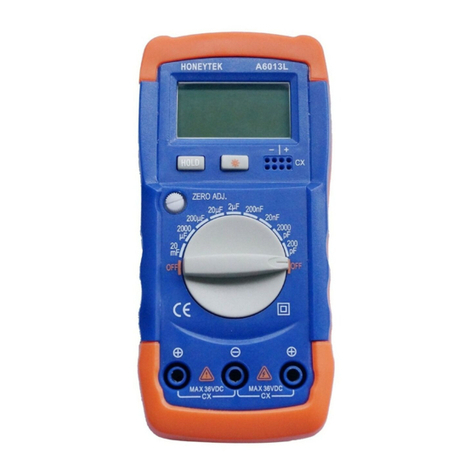
Accuracy: ±3% rdg ±5%
Spectral response: CIE photo optic
Note: The CIE photo optic curve is an international
standard for the color response of the average human eye.
The CIE standard illuminant ‘A’ is defined as a gas-filled
Tungsten filament lamp operating at a correlated color
temperature of 2856K.
Cosine response: f’2 ≤6%
Repeatability: ±2%
Temperature character: ±0.1%/℃
OPERATING INSTRUCTIONS
1> Set the function switch to the desired unit of measure; Lux or FC
Turn to MAX position, the meter captures and hold the maximum noise level
2> Select the LUX scale, set the range selection switch to desired lux range
3> Remove the photo detector cover and face it to light source in a horizontal
position
4> Read the luminance value on the LCD display, if the meter only display “OL”,
the input signal is too strong and a higher range should be selected
5> Data-hold mode: Press the hold button the LCD shows “HOLD”, the meter
stops all further measurements and only displays hold value. Press the HOLD
button again to exit Data-Hold mode.
6> When the measurement is completed, replace the light sensor cover and turn
the power off
BATTERY CHECK-UP & REPLACEMENT
1> When the battery power is low, LCD will display “low-battery” symbol, and
replacement of new battery is required.
2> Turn off the meter, disconnect the battery cover with a screw driver.
3> Disconnect the battery from the meter and replace it with a new battery and
screw the battery cover back into place.
MAINTENANCE
1> The white plastic disc on the top of the detector should be cleaned with a
damp cloth when necessary.
2> Do not store the instrument where temperature or humidity is excessively
high.
3> The reference level, as marker on the face plate, is the tip of the photo
detector globe
4> The calibration interval for the photo detector will vary according to
operational conditions, but generally the sensitivity decreases in direct
proportion to the product of luminous intensity by the operational time. In
order to maintain the basic accuracy of the instrument, periodic calibration is
recommended.





















